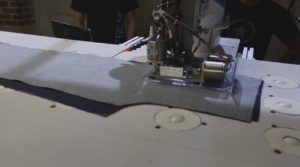Over the past year, popular demand to use protectionism to shield workers and companies from cheap foreign products has received more attention. But even from a young age I remember family members complaining about America’s manufacturing decline and how our nation is doomed because “we just don’t make stuff anymore”. The perception is if we’re not stamping “Made in the USA” on what we buy at Wal-Mart, we’re losing.
The sentiment is understandable, especially for families coping after a factory closure devastates their community. Even if the plant chugs along, workers remain anxious about whether they can compete globally. These legitimate concerns deserve not only attention but also realistic policy recommendations that don’t hurt the country as a whole. For those who believe in some form of free trade, saying “trust us” is insufficient.
With the upcoming presidential election, addressing specific candidates would be tempting. Yet anti-trade and protectionist sentiment appears on both the left and right, and concerns won’t disappear after November. If The Economist correctly predicted that future political debates will be between “open” versus “closed” positions instead of left versus right, this conversation has only begun. What follows thus avoids targeting any particular candidate but instead tries to address concerns and consider policies that could help.
Has US Manufacturing Decreased?
While lecturing at Mississippi community colleges about politics and economics, I would ask my students, “Do you think American manufacturing has increased or decreased since the 1970s?” For many, the answer seemed self-evident: “Decreased, of course.” Others would assume it was a trick question, so they’d say “increased”. I would then ask how their friends would answer, to which they generally admitted, “decreased”. The true answer: American manufacturing output has more than doubled since the 1970s, while manufacturing jobs have decreased.
The answer seems wrong. We’ve seen the empty factories, at least in political ads. Textile manufacturing has disappeared. We see “Made in China” on what we buy. Factories have moved to Mexico.
True, trade has allowed factories overseas to hire cheaper labor and then sell to America, and recent studies have shown that trade caused 1/5 of the manufacturing job losses from 1999 to 2011. Moreover, workers who lose their jobs due to trade face great difficulty finding new work and are more likely to drop out of the workforce or claim disability.
The Robots are Coming!
Nevertheless, trade is not the only reason why manufacturing employment has fallen. Machines and automation have helped American manufacturing become more productive so that output can increase with fewer workers. Similarly, tractors made farmers more efficient so that fewer were needed, and America became a top food producer. Due to new technology, as factories have returned to the US (yes, some manufacturing has returned through “reshoring”), the new plants have been more efficient and require fewer employees.
The threat of machines replacing workers became more apparent during my years as an adjunct professor. After a particular exam I approached a student about why he had done poorly, and he admitted, “I had to work the night shift at the chicken plant and didn’t get to study. I was exhausted.”
My heart broke for him because I knew his job boxing up processed poultry may disappear. At the time a friend of mine was going from chicken plant to chicken plant selling a new automated boxing system that would replace several employees. In an incredibly rural county with only 20,000 residents and few employers, my student would likely face difficulty unless he moved or learned new skills, both of which can be difficult for workers with a family or other responsibilities.
His troubles came not from cheap Chinese goods but from cheap machines. In fact, growing demand (and thus higher prices) for chicken from developing countries like China helped him.

Even the textile industry, which has long resisted automation, may soon undergo radical change. Traditionally, robots sew clothes poorly since the cloth has a tendency to bend or stretch (unlike steel or plastic), so workers must manually feed cloth into a sewing machine. Textile manufacturing has therefore moved to wherever labor is cheapest. However, companies like SoftWear Automation are improving technology so that robots can use cameras to monitor individual threads and make certain stitches go into the right spot, even if the cloth bends or stretches. This technology may help the industry to return to the US (which would provide several advantages), but the lost jobs Americans clamor for may not.
While new technology may destroy jobs, in the long term new surprising types of jobs usually emerge. Since 1980, computer spreadsheets took 400,000 jobs from bookkeepers and accounting clerks who did spreadsheets by hand, but the software helped create 600,000 accounting jobs. Companies asked more questions that spreadsheets could answer as making spreadsheets became easier. Humans have unlimited wants (or desires), so new technology allows more efficient workers to fulfill more desires without demand ever diminishing. The problem is whether workers can transition in the short term as technology and the economy changes.
Protectionism Fail
Even if protectionism forces companies to move jobs back home, the policies would cause significant misery for Americans, as Obama’s tariff on Chinese tires demonstrated on a smaller scale. A Peterson Institute study found the tariff saved at most 1,200 jobs (and probably fewer) at a cost of $1.1 billion to the economy (or $900,000 per job). Ultimately, working-class Americans who had the least spare cash suffered most. Even if they were willing to pay more for tires to help those workers, they would still have less money for their children’s education, a retirement fund, down payment for a home, or whatever else they prioritized. In turn, this destroys jobs in other sectors.
Higher prices from protectionism could be worthwhile if it created more jobs. But because new factories will be more efficient, revived protectionism would likely result in Americans spending more without enjoying enough jobs. They may even have to cut back because they can’t afford higher prices.
Moreover, as Donald Boudreaux at George Mason University recently argued, protectionism would harm workers’ specialization. As individuals, there’s no need to spend time learning how to be a plumber or doctor when we can hire a specialist. Instead of being jacks-of-all-trades, we spend our time doing what we’re good at and get better through experience. As we improve, we produce more and then earn more. As a country, trade allows Americans to specialize and earn more because we can pay others to, say, build an iPhone while we become expert smartphone and app designers. When we try to be self-sufficient, we become mediocre at everything. Similarly, if someone tries to be his own doctor, farmer, teacher, and plumber, he ends up sick, starving, ignorant, and with an overflowing toilet.
Help Workers Transition
Instead of the government shielding companies from foreign competition, Americans should help their neighbors transition into more competitive industries. The exact details of how should be debated and discerned through trial and error (especially on the state level). This help could take different forms, whether from the government or from civil society institutions like churches.
For instance, Germany has “Kurzarbeit” (or a “work-sharing” program) to help employees learn new skills. Instead of laying-off employees, a struggling company can give workers shorter hours while the government supplements their wages. Meanwhile, workers may take courses or complete other training to learn new skills. If the economy recovers, the company moves the now better-skilled workers back into full-time employment. If the company goes under, the workers still have their new skills. How this system could be applied to the US may take some tweaking, but liberal and conservative states could experiment to find the best method. An American Kurzarbeit could allow the labor force to improve skills and productivity as the economy changes.
Ultimately, improving productivity is what will increase Americans’ wealth, not tariffs. But not everyone can transition, so still other policies should be considered.

Agriculture has already endured a transitional phase as fewer and fewer farmers were needed in the fields. Steinbeck’s The Grapes of Wrath illustrates the difficult transition for families like the Joads, who are forced off their Oklahoma farm and face a difficult journey to California. But moving millions of workers off farms and into industries that needed their labor enhanced America’s prosperity. If the government had implemented policies to protect farmers from the transition, their children and grandchildren, and America as a whole, would be more impoverished today.
If Christians are called to care for their neighbors, they should help develop programs to support those whose skills are no longer in demand, whether because of trade or new technology. Using protectionism to keep workers in industries that no longer need their labor is ultimately unhelpful. Though the transition is difficult, especially for workers who have spent decades in an industry, America will prosper more in the long-term if workers specialize through trade and improve their productivity.
—
Mark Melton is the Deputy Editor for Providence. He earned his undergraduate degree in Foreign Language & International Trade from Mississippi College and then his graduate degree in International Relations from the University of St. Andrews. He taught political science at community colleges in Mississippi before moving to DC.
Photo Credit: By Vincent Ferron, via Flickr.






